Located in the middle of the central axis of Beijing, the Forbidden City, also known as the “Palace Museum”, used to be the imperial palace of the Ming and Qing dynasties (1368-1911) and is the essence of ancient Chinese palace architecture. The construction work began in 1406 and it took 14 years to complete. The architecture and design reflect the concept of “integration of man and nature” in ancient China, which also shows the legitimacy of the regime and the supremacy of imperial power.
What is the Forbidden City in Beijing:
- It is one of the largest and most complete ancient wooden architecture complexes in the world.
- It is honored as the head of the five palaces of the world (others are Versailles Palace in France, Buckingham Palace in Britain, the White House in the United States and the Kremlin in Russia).
- It was listed as a World Cultural Heritage Site in 1987 by UNESCO.
- Nowadays, it is the most renowned museum in China with a large number of ancient Chinese art treasures.
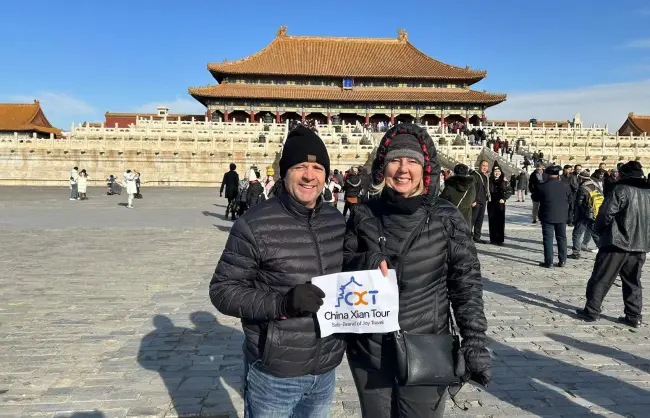
Basic Facts about Forbidden City in China:
1. Where is the Forbidden City?
It is located at No. 4 of Jingshan Front Street in Dongcheng District of Beijing, which is the very heart of the capital city. It is only a short walk away from iconic landmarks, such as Tian’anmen Square, the National Museum of China, and Beihai Park, as well as the prosperous Wangfujing Street and Nanluoguxiang (South Gong and Drum Lane).
2. How big is the Forbidden City?
Covering an area of more than 720,000 square meters, it is a rectangular-shaped city of 961 meters long and 753 meters wide. And it’s surrounded by a 10-meter-high wall and a 52-meter-wide moat.
3. How many rooms are in the Forbidden City?
The construction area of the palace is about 150,000 square meters. It is said that in total 9,999.5 rooms were built inside. But a statistic conducted by the former director of the Palace Museum indicates that 9,371 rooms have been well preserved today.
4. When was the Forbidden City built (How old is the Forbidden City)?
This royal palace has a long history of over 600 years. The construction work began in 1406 and was completed in 1420.
5. Why was the Forbidden City built?
Emperor Yongle (1360-1424) intended to move the capital from Nanjing to Beijing after enthroned, and ordered the construction of the Forbidden City as the imperial palace in Beijing.
6. Who lived in the Forbidden City?
It was the living place for the imperial family of the Ming and Qing dynasties. How many emperors lived in the Forbidden City? After completion, 24 emperors had taken this complex as their residence, 14 of the Ming Dynasty and 10 of the Qing Dynasty.
7. Why is it called the Forbidden City?
In the old days, the palace was heavily guarded to ensure the privacy and safety of the royal family. Ordinary people were not allowed to enter this imperial area, hence the name.
8. Is the Forbidden City still forbidden today?
Absolutely not. This grand complex has been open for visiting since 1925. Any visitor is able to admire the magnificent halls and have a glimpse into the life of the ancient royal family.
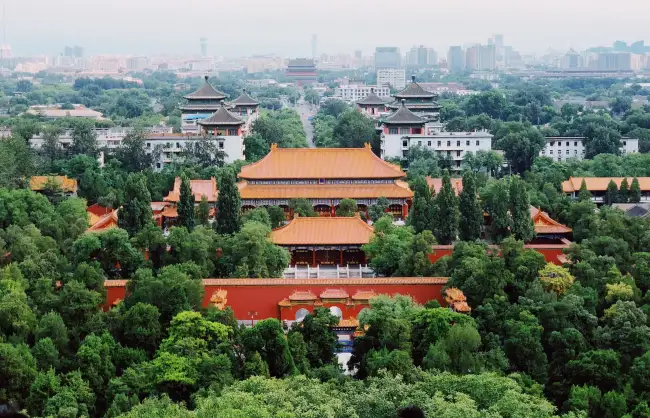
What was the Forbidden City Used for?
It was the imperial palace during the Ming and Qing dynasties and was the center of the supreme power at the time. It consists of over 9,000 structures built for different purposes. There are magnificent Hall of Supreme Harmony, Hall of Central Harmony, and Hall of Preserving Harmony, which were built for holding grand national ceremonies; chambers such as Palace of Heavenly Purity, Hall of Celestial and Terrestrial Union, and Palace of Earthly Tranquility were the living quarters for emperors and empresses; there also lies an exquisite Imperial Garden and some Buddhist architectures as the recreational area inside the palace…
History of the Forbidden City
The construction work of the palace can be traced back to 1406 when Emperor Yongle decided to relocate the capital to Beijing and ordered to build a royal palace there based on the one in the former capital, Nanjing. Who designed and built the Forbidden City? It is said that Kuai Xiang, a renowned architect in the Ming Dynasty, was the leading designer of the complex, who completed the architectural drawing and directed the building of this royal palace.
The construction of the royal palace and the city of Beijing was completed after 14 years. The next year, the Ming court moved in. Ever since then, the Forbidden City had been the core of the state power until the overthrow of the Qing Dynasty in 1911.
On October 10th, 1925, the complex was rebuilt as the Palace Museum displaying imperial architecture and precious artifacts to the public. In 1987, it was declared a UNESCO World Heritage site. Today, the palace has become one of the most-visited tourist attractions in Beijing, and even in China, drawing some 8 million visitors from home and abroad each year.
√Related reading: Shopping Guide for Forbidden City Souvenirs
Layout of the Forbidden City
The palace is seated at the central point along the north-south axis of Beijing City, with all the architecture inside symmetrically distributed. The whole complex consists of three parts: defensive facilities, the Outer Court, and the Inner Court.
Defensive Facilities – Moat, City Wall, Watchtowers, Gate Towers
This imperial palace in China is encircled by a 12-meter-high wall with a watchtower built at every corner. Outside the wall is a moat which is about 52 meters wide. Along the wall, there are four gates exactly facing the four directions. The one to the south is called the Meridian Gate, which is now the main entrance for visiting. Others are Gate of Divine Prowess to the north, East Prosperity Gate and West Prosperity Gate.
The Outer Court – Where the State Held Great Events
The Outer Court was a setting for state occasions and royal hospitality during the Ming and Qing dynasties. The center of the Outer Court is the three main halls: the Hall of Supreme Harmony, the Hall of Central Harmony, and the Hall of Preserving Harmony.
- The Hall of Supreme Harmony (Taihe Dian) was used for performing important events, such as coronations, emperors’ weddings, investitures… It is the largest building of the entire site, covering an area of 2,377 square meters, and is luxuriously decorated with elements that were exclusively used for imperial architecture, including dragon patterns and glazed ridge statues, representing the highest construction rank in ancient times.
- The Hall of Central Harmony (Zhonghe Dian) served as the resting place for emperors before the ceremonies at the Hall of Supreme Harmony. If there was a worship ritual, emperors would inspect their speeches here in advance.
- The Hall of Preserving Harmony (Baohe Dian) was built for holding court banquets and imperial examinations in the old days.
The Inner Court – Where Emperors and Royal Families Lived
Walk through the Gate of Heavenly Purity and you will reach the Inner Court. It was where emperors handled state affairs and was also the living quarter for the royal family. And there are also three major buildings: the Palace of Heavenly Purity, the Hall of Celestial and Terrestrial Union, and the Palace of Earthly Tranquility.
- The Palace of Heavenly Purity (Qianqing Gong) is the primary hall of the Inner Court. It was originally built as a residence for the emperors and later became a place for emperors to work and hold festive ceremonies.
- The Hall of Celestial and Terrestrial Union(Jiaotai Dian) was where officials paid respects to empresses at important festivals. In the Qing Dynasty, it was turned into a place to store the imperial jade seal.
- The Palace of Earthly Tranquility (Kunning Gong) was used as the residence for empresses during the Ming Dynasty and later became the place of worship.
On the wings lie the Six Western Palaces and the Six Eastern Palaces. These structures were the living chambers for concubines, most of which followed the design of elegant courtyards. At the very end of the Inner Court is the exquisite Imperial Garden, a serene and beautiful place for the royal family to have some leisure time.
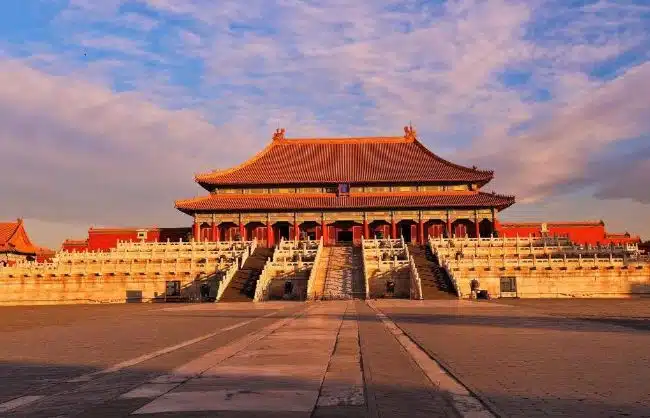
Architectures of the Forbidden City
- This imperial palace of China follows a symmetrical layout, with the main buildings lying along the central axis. The Outer Court is the main body of the complex and occupies more than half of the whole area. The entire design displays a strong sense of order and hierarchy.
- As the world’s largest and the most well-preserved wooden architecture, the construction of the Forbidden City involved no nail or binder, but lots of tenon and mortise joints.
- Golden yellow and red are the dominant hues of the complex. In Chinese culture, it represents prosperity and good fortune, while yellow is the color of the earth, which was considered the origin of all the living things on earth and thus became the symbol of supreme power, exclusive to the royal family.
- Almost all the architecture inside Forbidden City is adorned with color paintings, and the patterns strictly match with the construction rank of the buildings. For example, dragon, as the incarnation of emperors, is a pattern of the highest level, which can only be used at major imperial palaces; floral pattern comes second and often appears on official architecture; next are images of animals, figures and scenery, which was largely applied in imperial gardens…
- There are 6 pairs of bronze lions guarding major palaces in the complex. The one on the left is the male lion stepping on a ball with its right leg. It was considered the symbol of power in ancient times. The one on the right is a female playing with a cub, which means lots of descendants according to ancient Chinese culture. The two lions at the Gate of Supreme Harmony are the largest in the whole area, with a height of up to 2.4 meters.
Collections of the Forbidden City
This imperial palace houses more than 1.8 million precious antiques, from paintings and calligraphy to gold and silver wares, from enamels and ceramics to textiles and jewelry… There are two permanent exhibitions at the Treasure Gallery and the Gallery of Clocks.
- The Treasure Gallery (at the Palace of Tranquil Longevity) displays more than 400 pieces of carefully-selected imperial artifacts, such as jewelry, gold and silver wares, jade and gemstone bonsai. All of them represent the highest level of Chinese traditional handicrafts of the time.
- The Gallery of Clocks (at the Hall for Ancestral Worship), as its name indicates, boasts over 1,500 Chinese timepieces and masterpieces from the UK, France and Switzerland, all of which were made from the 18thcentury to the 20th
How to Tour the Forbidden City?
There are various kinds of routes to tour this imperial palace in Beijing depending on the visiting hours. And there is a map of the Forbidden City below every route to show you how it goes.
1. The Tour Routes in 2 Hours
Two hours is enough for tourists to visit palaces on the central axis, namely the Hall of Supreme Harmony, the Hall of Central Harmony, the Hall of Preserving Harmony, the Palace of Heavenly Purity, the Hall of Celestial and Terrestrial Union, and the Palace of Earthly Tranquility.
Although the schedule may be tight, it is still possible for visitors to view some exhibitions on this tour line. More details about current exhibitions could be found in the official website of the palace.
- Option 1:
The Meridian Gate → Gate of Supreme Harmony → Pavilion of Spreading Righteousness → Hall of Supreme Harmony → Hall of Central Harmony → Hall of Preserving Harmony → Gate of Heavenly Purity → Palace of Heavenly Purity → Hall of Celestial and Terrestrial Union → Palace of Earthly Tranquility → Imperial Garden → Gate of Divine Prowess
- Option 2:
The Meridian Gate → Gate of Supreme Harmony → Hall of Supreme Harmony → “Treasures from the Qing Palace” at rooms along the western corridor of the Hall of Preserving Harmony → “Memory of the Old Palace” at rooms along the eastern corridor of the Hall of Preserving Harmony → Hall of Central Harmony → Hall of Preserving Harmony → Gate of Heavenly Purity → Palace of Heavenly Purity → Hall of Celestial and Terrestrial Union → Palace of Earthly Tranquility → Imperial Garden → Gate of Divine Prowess
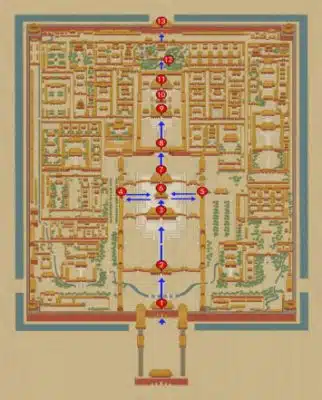
2. The Tour Routes of Half-A–Day
If visitors would like to take half a day to visit this palace, they could explore not only the central axis but also the Six Palaces in east and west, the Treasure Galley and the Gallery of Clocks.
- Option 1:
The Meridian Gate → “The Ceramics Gallery” at the Hall of Literary Brilliance → Gate of Supreme Harmony → Hall of Supreme Harmony → Hall of Central Harmony → Hall of Preserving Harmony → “The Gallery of Clocks” at the Hall for Ancestral Worship → Palace of Heavenly Purity → Hall of Celestial and Terrestrial Union → Palace of Earthly Tranquility → Hall of Mental Cultivation → Six Western Palaces → Imperial Garden → Gate of Divine Prowess
- Option 2:
The Meridian Gate → “Painting and Calligraphy Gallery” Hall of Martial Valor → Gate of Supreme Harmony → Hall of Supreme Harmony → Hall of Central Harmony → Hall of Preserving Harmony → Palace of Heavenly Purity → Hall of Celestial and Terrestrial Union → Palace of Earthly Tranquility → Six Eastern Palaces → Hall for Abstinence → “the Treasure Gallery” at the Palace of Tranquil Longevity → Inner Court of Palace of the Tranquil Longevity → Gate of Divine Prowess
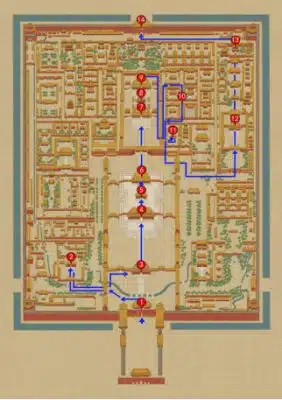
3. The Tour Route of One Day
The one-day tour could cover almost all the important buildings but it is also necessary for visitors to make a schedule to arrange time appropriately.
The Meridian Gate → “Painting and Calligraphy Gallery” Hall of Martial Valor → “Ceramics Gallery” Hall of Literary Brilliance → Gate of Supreme Harmony → Hall of Supreme Harmony → Hall of Central Harmony → Hall of Preserving Harmony → Palace of Heavenly Purity → Hall of Celestial and Terrestrial Union → Palace of Earthly Tranquility → Hall of Mental Cultivation → Six Western Palaces → Imperial Garden → Six Eastern Palaces → “the Gallery of Clocks” at the Hall for Ancestral Worship → “the Treasure Gallery” at the Palace of Tranquil Longevity → Gate of Divine Prowess
Best Beijing Tours including the Forbidden City:
How to Buy Entrance Tickets:
- Price of Entrance Tickets:
The ticket price is different in peak season (Apr. 1st to Oct. 31st) and low season (Nov. 1st to Mar. 31st).
| Peak Season | CNY 60 |
| Low Season | CNY 40 |
| The Treasure Gallery | CNY 10 |
| The Gallery of Clocks | CNY 10 |
Notes: The Palace Museum is limiting the number of visitors to 40,000 per day and doesn’t sell tickets on the day of your visiting. So, please be sure to make a reservation in advance.
- Opening Hours:
The Palace Museum is open from Tuesdays to Sundays and closed on Mondays except for official holidays. The opening time is different according to the peak season and low season.
| Peak Season | 8:30-17:00 (last entry at 16:00) |
| Low Season | 8:30-16:30 (last entry at 15:30) |
Notes: There may be changes in the time during Chinese official holidays or when some important events occur. Please check the related information before the visit.
When is the Best Time for the Forbidden City Tour?
Each moment of this imperial palace is attractive, especially in autumn (September – November) and winter (December – February). In autumn, the red walls and golden ginkgo leaves enhance the beauty of each other. When it snows in winter, walking around the snow-covered halls is like being transferred to the bygone era, which is really an unusual experience during the China tours.
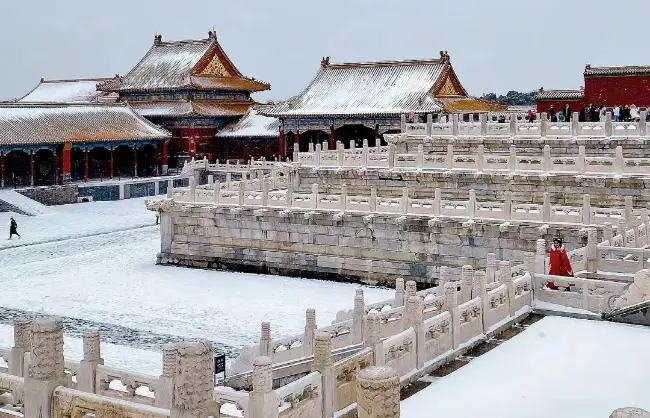
How to Get to the Forbidden City?
The Meridian Gate, the southern gate of the palace, is the only entrance for visitors. People can get there by convenient public transportation.
By Bus
- There are many bus lines for tourists to choose, such as bus line 1, 2, 52, 82 and 120, as well as sightseeing bus line 1 and 2. Visitors can get off the bus at Tian’anmen East Station and then walk about 900 meters to get to the entrance.
- Visitors could also get off at Tian’anmen West Station. Bus line 1, 5, and 52, as well as sightseeing bus line 1 and 2 are available there.
By Subway
Visitors can take subway line 1 and get off at Tian’anmen East Station (Exit B) or Tian’anmen West Station (Exit B), and then walk about 900 meters to reach the Meridian Gate.
Where to Eat & What to Eat
There are both Chinese and Western restaurants inside the Forbidden City to meet visitors’ different needs.
Palace Museum Restaurant (故宫餐厅)
It serves a variety of Chinese cuisines such as Kung Pao Chicken, Cantonese fried rice, Beijing-style fried bean sauce noodles and steamed dumplings.
Location: near the entrance of the Treasure Gallery and the Gallery of Clocks
Bingjiao (冰窖餐厅)
The restaurant has been converted from an underground icehouse, offering both Chinese set meals as well as Western fast foods, coffee, and beverages.
Location: near the Garden of Compassion and Tranquility
Palace of Earthly Tranquility East Courtyard (坤宁东院)
The Chinese-style afternoon tea is the specialty of this restaurant. All the light refreshment is elaborately designed to have an exquisite appearance and special meanings.
Location: to the east of the Palace of Earthly Tranquility
Corner Tower Cafe (角楼咖啡)
It serves various coffee, milk tea and desserts, which is a nice place to recharge your battery after the Forbidden City tour.
Location: outside the Gate of Devine Prowess on the left









